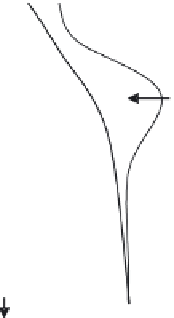Geoscience Reference
In-Depth Information
-1 (or 100% losses)
+1 (or +100% gains
= doubling of
the initial quantities)
0
Change of
volume
Index
mineral
Iron
CaCO
3
LOSSES
GAINS
Level of losses or gains
Fig. 1.7
Example of the representation of losses and gains during weathering, from the
bottom up in a soil profi le, assuming an index mineral as unchanging (Driese
et al.
2000).
In the tropical zone, at the time scales generally considered, quartz
is soluble. The index mineral elements often used are partly titanium,
Ti, abundant in rutile (TiO
2
) and partly zirconium, Zr, contained in the
silicate zircon (Egli and Fitze 2000). But these elements are scarce and
it is difficult to accurately determine the contents of each and more so
their ratio between two horizons. Furthermore, Ti can migrate in soils
that have undergone intense weathering (Cornu
et al.
1999). As for Zr,
it is sometimes of aeolian origin (Stiles
et al.
2003). The choice of the
appropriate index mineral is, therefore, to be carefully reasoned out in
each case.
1.2.5 Test Minerals
For investigating the current processes in the soil, small porous-plastic
sachets containing
test-minerals
can be buried in it. These are first
weighed, examined under the electron microscope and analysed before
being placed in the field in selected soils. At the end of the experiment
(season, year, etc.), the minerals are recovered and studied again. The
method enables us to calculate the rates of weathering or dissolution
in a selected soil horizon under a given climate. Locating the buried
test-minerals months later is very difficult even if the sachets had been
placed in a location precisely defined with GPS, measurements taken,
a sketch drawn and photographs taken of the site. We must therefore
proceed on the basis of the principle that only one-half of the sachets will










